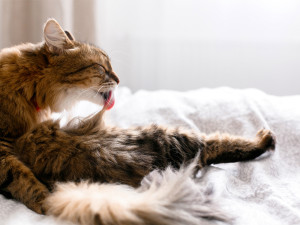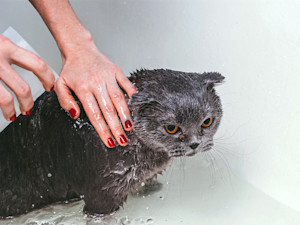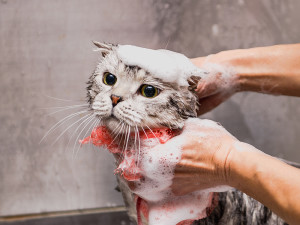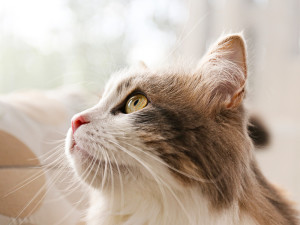A Guide to Cat Acne: Find Solutions to Clear Your Cat’s Skin
That's right—your cat can get acne. Here’s how to spot it and treat it.
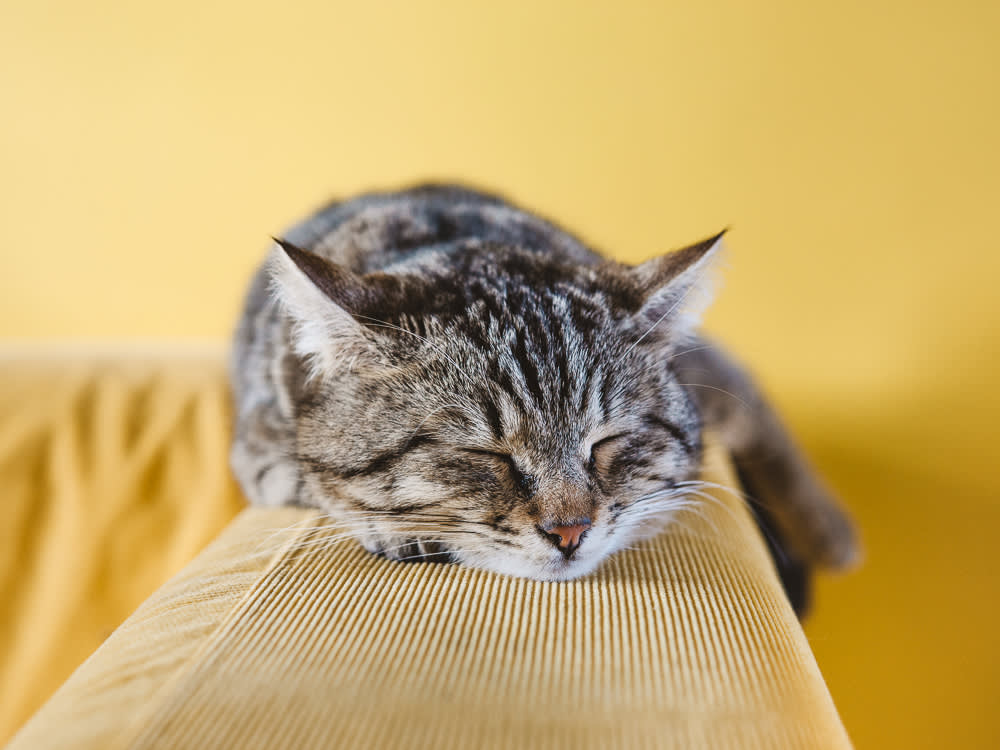
Share Article
In This Article:
What Is Cat Acne? Symptoms of Cat Acne What Causes Cat Acne How Vets Diagnose Cat Acne Cat Acne Treatments Cat Acne Recovery and Management Cat Acne Prevention
Cats, they’re just like us. They love naps… and they get acne. If your cat’s chin looks like the “before” picture in a late-night Proactiv commercial, read on for how you can treat the breakout before Dr. Pimple Popper surfaces on Nat Geo one day. (And a disclaimer that human acne medicine should never be used on cats; learn what’s actually safe below.)
What is cat acne?
You don’t hear much about skin disorders in cats compared to dogs. If a cat is itchy and has irritated skin, a flea allergy is the first thing the vet thinks about.
Acne is often overlooked in cats because it can be difficult to see. It is usually mild and doesn’t seem like a big deal. However, it can turn into an infection with severe inflammation. Blackheads, pustules, or scabs can overwhelm your cat’s chin and lips if it’s not treated when it’s mild. In this article, we’ll go over the causes and treatment options, so you can help keep your kitty’s skin healthy and acne-free.

What does cat acne look like?
If you have ever seen flea “dirt,” cat acne is very similar, except that it tends to just be around the chin and lower lip area. It looks like tiny black specks and can remain like that for a very long time — or can become red, swollen, and pus-filled if left untreated.
Symptoms of cat acne
You may not see all the following symptoms in your cat. But if you see any of these, you might want to treat it with our tips (“Cat acne treatments,” below), or see your vet.
Blackheads or dark specks on the chin and around the lips
Swelling and redness of the chin
Pustules or pimples filled with pus
Scabs or crusts on the chin
Excessive scratching or rubbing of the face
Hair loss on the chin
Chin pain, when touched
If symptoms persist and home treatment doesn’t help, definitely see your veterinarian.
What causes cat acne?
Several things can cause feline acne, but the root reason in many cases is that the chin is dirty. Another major cause can be allergies. Here are some factors that can cause cat acne.
Dirty food and water bowls: You may need to clean your cat’s dishes more often.
A reaction to plastic: Switch your plastic bowls to metal or ceramic ones.
Poor grooming habits: Some cats may not be as fastidious groomers as others, and you may need to clean their chins for them.
Excessive oil production: This can clog pores.
Stress and anxiety: Yes, cats have these issues, too, and they can cause skin problems.
Allergies: Sensitivities to food, cleaning products, or environmental factors may trigger breakouts.
Weakened immune system: If your cat has other health problems, such as diabetes or thyroid disease, their immune system may be weakened, making them more prone to acne.
Some cases of feline acne can be treated at home, but more severe cases require a veterinarian.
How veterinarians diagnose cat acne
A veterinarian can diagnose feline acne in the following ways.
A close look at the affected area during a physical examination may be all that is needed.
If the physical exam isn’t enough, cytology or skin scraping may be needed to rule out infections, fungal issues, and parasites.
A biopsy may be needed, but that’s rare.
Usually, your veterinarian will tell you how to keep your cat’s chin clear and prescribe some medication.
Cat acne treatments
Mild cases of cat acne may just require cleaning your cat’s chin with antiseptic wipes, benzoyl peroxide, or chlorhexidine. Medicated shampoos can treat feline acne and prevent it by preventing oil buildup. If a bacterial infection has developed, antibiotics may be needed. In severe cases, a steroid may be added. Switching to stainless steel or ceramic bowls can reduce allergies and bacteria.
Recovery and management of cat acne
With proper care, most cases of cat acne can be managed effectively.
Clean the chin daily with veterinary-recommended wipes.
Avoid plastic bowls.
Monitor for signs of infection, and seek veterinary help if needed.
Reduce stress.
See your veterinarian if these steps don’t make the acne go away.
How to prevent cat acne
Prevention is the best way to keep your cat’s skin healthy and acne-free. Here are some treatment methods to prevent acne, which are very similar to preventative measures.
Clean food and water bowls daily.
Use stainless steel or ceramic bowls.
Maintain a healthy diet.
Minimize stress.
FAQs
How long does feline acne last?
The answer varies from cat to cat. If you start treatment early and are diligent about it, it may clear up within a few weeks.
What happens if cat acne is untreated?
Left untreated, cat acne will worsen, leading to infections, abscesses, and scarring. It can become quite painful for your cat. Occasionally, the condition becomes chronic, even with treatment, and requires long-term management. If your cat’s acne persists despite treatment, consult your veterinarian. They may need to adjust medications, conduct further tests, or explore underlying conditions such as allergies or hormonal imbalances.
Bottom line
Understanding and addressing feline acne ensures your cat maintains healthy, clear skin while minimizing discomfort and infections.
Start treatment at the first sign of the condition.
If it becomes severe, don’t hesitate to go to the vet.
If left untreated, feline acne can become quite uncomfortable for your cat.
References
Craig E., Griffin. “How I Treat Feline Acne.” Cabi Digital Library, https://www.cabidigitallibrary.orgopens in new tab, 2009, www.cabidigitallibrary.org/doi/pdf/10.5555/20093115176opens in new tab.
Jazic, E., et al. “An Evaluation of the Clinical, Cytological, Infectious and Histopathological Features of Feline Acne.” Veterinary Dermatology, vol. 17, no. 2, Apr. 2006, pp. 134–140, https://doi.org/10.1111/j.1365-3164.2006.00507.xopens in new tab.
White, Stephen D., et al. “Feline Acne and Results of Treatment with Mupirocin in an Open Clinical Trial: 25 Cases (1994–96).” Veterinary Dermatology, vol. 8, no. 3, Sept. 1997, pp. 157–164, https://doi.org/10.1046/j.1365-3164.1997.d01-16.xopens in new tab.

Dr. Shelby Neely, DVM
Dr. Shelby Neely is a freelance writer and veterinarian who graduated from the University of Pennsylvania School of Veterinary Medicine and has practiced veterinary medicine for 30 years, specializing in small animals. Her work has appeared in Allivet, AsktheCatDoctor, WhiskerDocs, Ask the Cat Doctor Radio, Ask the Cat Doctor TV, and numerous other websites, brochures, newsletters, newspapers, and ebooks. In her spare time, Dr. Neely likes to spend time with her three children, two grandchildren, three cats, two grand-cats, and five grand-dogs.

Dr. Alycia Washington, DVM, MS
Alycia Washington is a small-animal emergency veterinarian with over 10 years of experience based in North Carolina. She works as a relief veterinarianopens in new tab and provides services to numerous emergency and specialty hospitals. She also works as a veterinary writer with a focus on educating pet parents.
Related articles
![cat with cone after vet visit]()
How Often Should You Take Your Cat to the Vet?
Get thy cat to a vet, even if it’s a struggle to get them out the door.
![A grey cat looking at a dish of fish]()
The 5 Best Fish Oils for Cats
The next best thing to branzino, omega-3s support your cat’s skin, brain, joint, and heart health.
![Grey Scottish fold cat takes a bath with his owner.]()
How to Give Your Cat a Bath
Pro tip: Take things step by step.
![Cat being washed by a groomer]()
Does My Cat Need a Professional Groomer?
If you thought your cat was a self-cleaning evolutionary marvel, you’re not wrong but...
![Three eco-friendly pet grooming products displayed in a collage.]()
11 Eco-Friendly Pet Grooming Products
Package-free brushes, plant-based wipes, certified-organic shampoos, and more.
![Cat enjoying laying on girl's legs and being cuddled]()
New Research Aims to Reduce Cat Stress During Nail Trims
Plus, expert advice on how to trim your cat’s nails at home.
![Portrait of siberian cat with green eyes by the window.]()
How to Prevent—or Treat—Cat Ear Infections
How to prevent an ear infection (and treat one if it’s too late).


